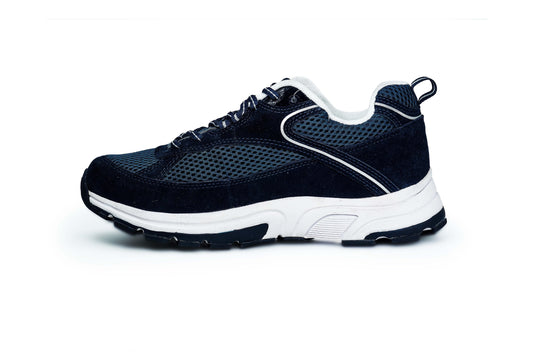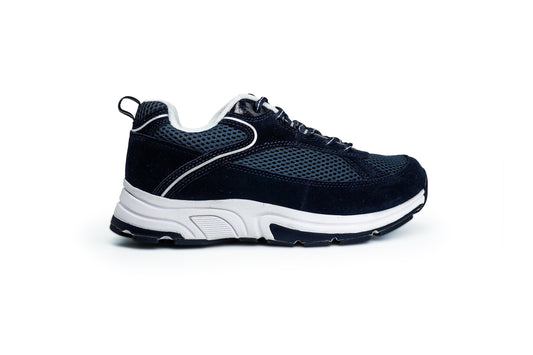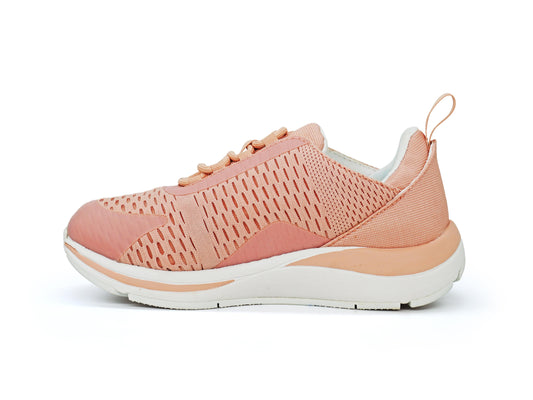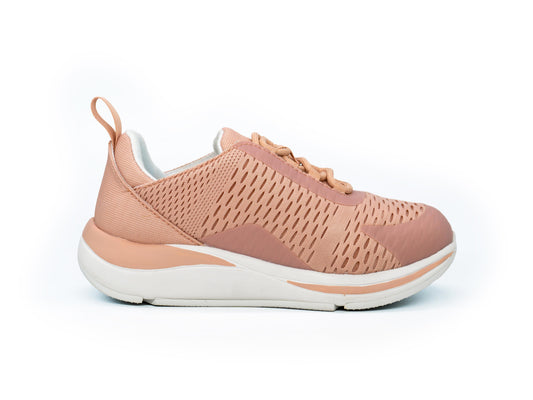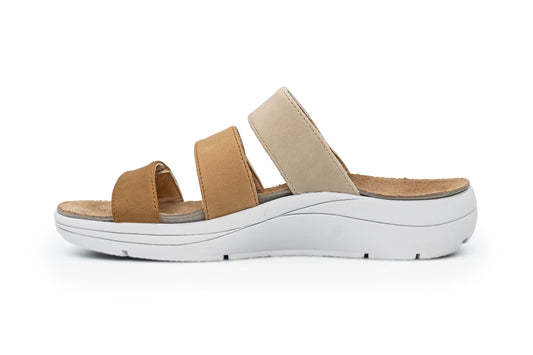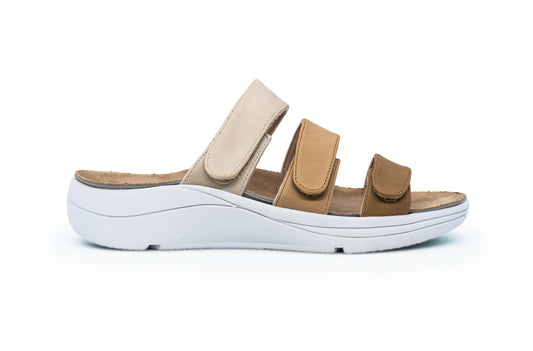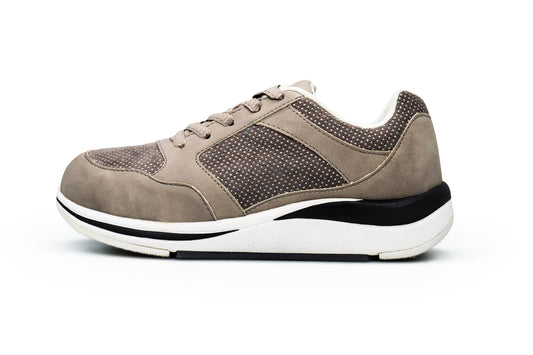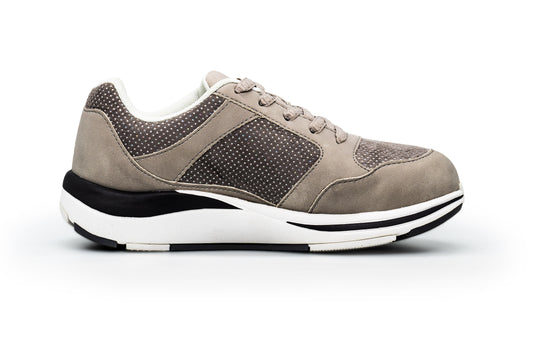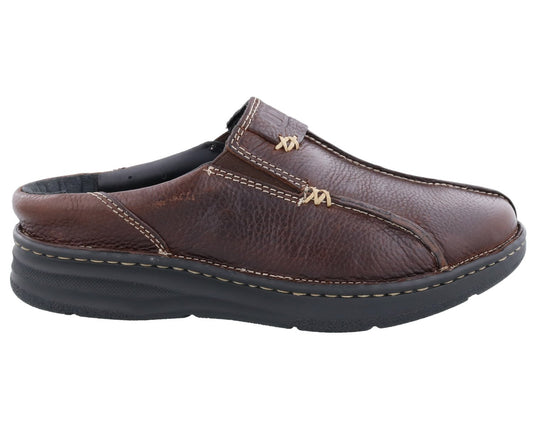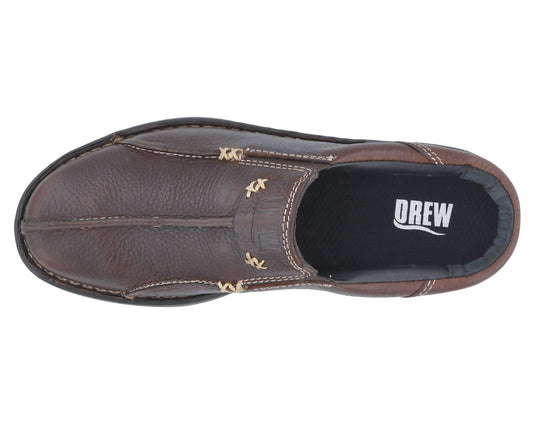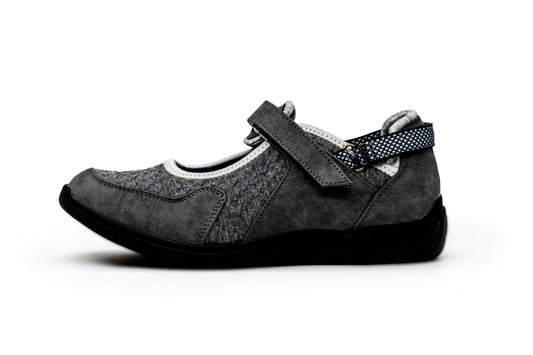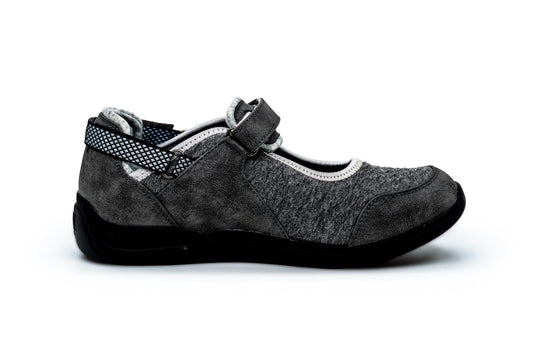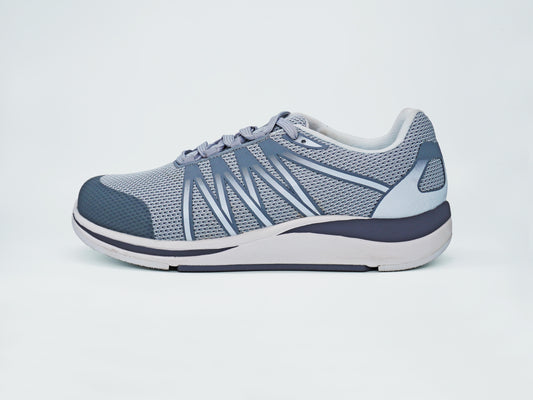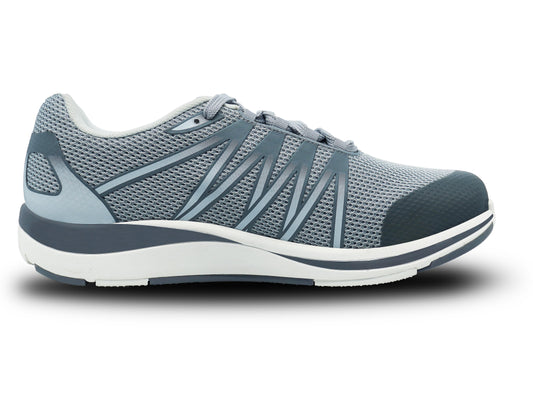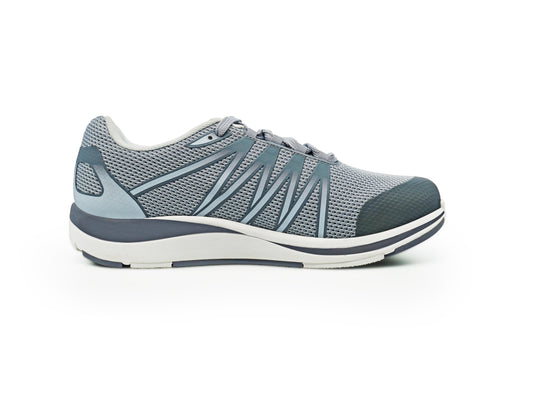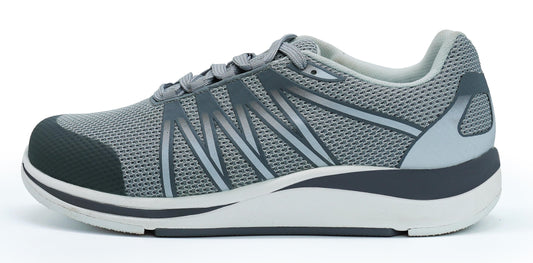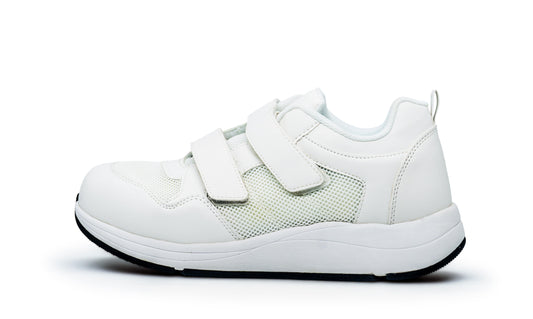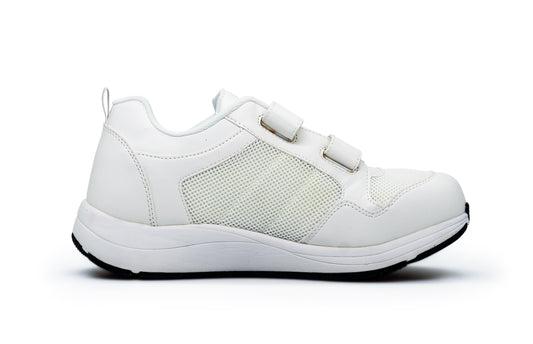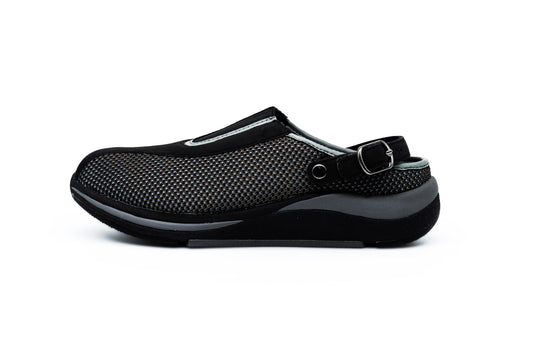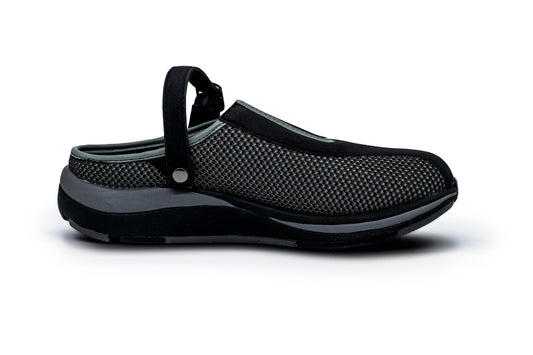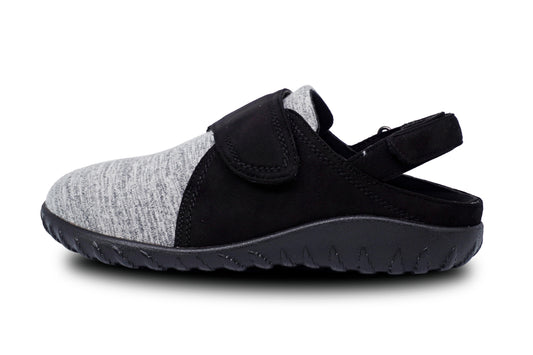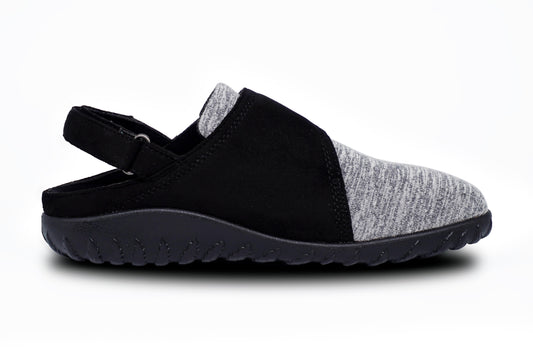-
Vendor: MENS
AARON Diabetic & Orthopedic Athletic Shoes - Mens - Navy Suede/Mesh
Walk in confidence knowing Drew Aaron only available exclusive at DiabeticShoe.in offers the proprietary Plus Fitting System® with two removable insoles plus all the therapeutic benefits Drew is famous for. With shock-absorbing inserts, flared outsoles, firm heel counters and Drilex® linings to wick away...- ₹ 11,695
₹ 12,995- ₹ 11,695
- Unit price
- / per
-
Navy Suede/Mesh
-
Vendor: WOMENS
SPRINTER Diabetic & Orthopedic Athletic Shoe Rose - Womens - Rose Combo
The Sprinter women's lace-up sneaker by Drew only available exclusively at Diabeticshoe.in features our Walk Right Technology Insole and is engineered for protection and superior comfort. A slip-resistant outsole will keep you on your feet. The high rebound EVA midsole provides shock absorption to...- ₹ 11,695
₹ 12,995- ₹ 11,695
- Unit price
- / per
-
Rose Combo
-
Grey Mesh Combo
-
Vendor: WOMENS
SAWYER Diabetic & Orthopedic Sandal - Womens - Blue Combo
Sawyer womens sandals by Drew® at DiabeticShoe.in combine an updated modern look with a hard-to-find removable insole. The removable Walk Right Technology™ footbed makes Sawyer one of the most comfortable women's sandals around! Featuring a lightweight outsole and three hook and loop adjustable straps,...- ₹ 8,995
₹ 10,995- ₹ 8,995
- Unit price
- / per
-
Blue Combo
-
Natural Combo
-
Vendor: WOMENS
CHIPPY Diabetic & Orthopedic Athletic Shoes - Womens - Grey Combo
Drew Chippy exclusively available at Diabetic Shoe India is our most popular casual shoes for women offers a great, new look for Drew. Chippy shoes are one of the industry's few walking shoes with double depth and two removable insoles that can accommodate prescribed...- ₹ 10,795
₹ 11,995- ₹ 10,795
- Unit price
- / per
-
Grey Combo
-
Vendor: MENS
JACKSON Diabetic & Orthopedic Sandal - Mens - Brown Pebbled Leather
One step into this clog, and you'll feel like you're walking on clouds. Great-looking tumbled leathers make Drew® Jackson the most requested clog in the industry. available exclusive at DiabeticShoe.in These Drew men's shoes define quality, comfort, support and stability. Drew Jackson are fully...- ₹ 11,695
₹ 12,995- ₹ 11,695
- Unit price
- / per
-
Brown Pebbled Leather
-
Vendor: WOMENS
BUTTERCUP Diabetic & Orthopedic Sandal - Womens - Grey Combo
The Drew® Buttercup available in India exclusively at DiabeticShoe.in is our best orthopedic shoe yet ! This popular women's shoe offers beautiful, detailed styling with the convenience and comfort of an adjustable hook and loop closure at the top of the foot with a detachable strap...- ₹ 11,695
₹ 12,995- ₹ 11,695
- Unit price
- / per
-
Grey Combo
-
Vendor: MENS
PLAYER Diabetic & Orthopedic Athletic Shoes - Mens - Grey Mesh
The men's Player offers Drew with Walk Right Technology™ and is engineered for protection and superior comfort and support only avaiable to buy at Diabetic Shoe India. A slip-resistant outsole will keep you on your feet. The high rebound EVA midsole provides shock absorption...- ₹ 10,795
₹ 11,995- ₹ 10,795
- Unit price
- / per
-
Grey Mesh
-
Vendor: WOMENS
BALANCE Running Shoes - Womens - Grey Mesh
The Balance women's athletic shoe features our Walk Right Technology™ Insole and is engineered for protection and superior comfort. A slip-resistant outsole will keep you on your feet. The high rebound EVA midsole provides shock absorption to reduce foot and leg fatigue. Complete with...- ₹ 10,795
₹ 11,994- ₹ 10,795
- Unit price
- / per
-
Grey Mesh
-
Vendor: MENS
CONTEST Diabetic & Orthopedic Sneaker- Mens - White Combo
The Contest by Drew men's double hook and loop sneaker is engineered for superior comfort exclusively available to buy from Diabetic Shoe India. A slip-resistant outsole will keep you sure on your feet. The high rebound EVA midsole provides shock absorption to reduce foot...- ₹ 10,795
₹ 11,995- ₹ 10,795
- Unit price
- / per
-
White Combo
-
Vendor: WOMENS
PURSUIT Slip-On Sneaker - Womens - Black Mesh Combo
Drew's Pursuit slip-on sneaker exclusively available at Diabetic & Orthopedic Shoe India for women is a multi-functional shoe designed with the utmost comfort in mind. Pursuit can be slipped on with ease and can be worn with or without the ankle strap. It's extremely...- ₹ 9,895
₹ 11,995- ₹ 9,895
- Unit price
- / per
-
Black Mesh Combo
-
Vendor: WOMENS
BREEZY Slipper Footwear - Womens - Black Microsuede/Stretch
Exclusive textures and comfortable design is a smash success in the womens Breezy slip-on by Barefoot Freedom® by Drew® only available exclusive at DiabeticShoe.in. Adjustable hook and loop closure at the heel and vamp allow for a customized fit. Stretch fabric along with a supportive,...- ₹ 9,995
₹ 10,995- ₹ 9,995
- Unit price
- / per
-
Black Microsuede/Stretch
Trending Now
Popular Products
Vendor:
MENS
AARON Diabetic & Orthopedic Athletic Shoes - Mens - Navy Suede/Mesh
Walk in confidence knowing Drew Aaron only available exclusive at DiabeticShoe.in offers the proprietary Plus Fitting System® with two removable insoles plus all the therapeutic benefits Drew is famous for. With shock-absorbing inserts, flared outsoles, firm heel counters and Drilex® linings to wick away...
- ₹ 11,695
₹ 12,995- ₹ 11,695
- Unit price
- / per
-
Navy Suede/Mesh
Vendor:
WOMENS
SPRINTER Diabetic & Orthopedic Athletic Shoe Rose - Womens - Rose Combo
The Sprinter women's lace-up sneaker by Drew only available exclusively at Diabeticshoe.in features our Walk Right Technology Insole and is engineered for protection and superior comfort. A slip-resistant outsole will keep you on your feet. The high rebound EVA midsole provides shock absorption to...
- ₹ 11,695
₹ 12,995- ₹ 11,695
- Unit price
- / per
-
Rose Combo
-
Grey Mesh Combo
Vendor:
WOMENS
SAWYER Diabetic & Orthopedic Sandal - Womens - Blue Combo
Sawyer womens sandals by Drew® at DiabeticShoe.in combine an updated modern look with a hard-to-find removable insole. The removable Walk Right Technology™ footbed makes Sawyer one of the most comfortable women's sandals around! Featuring a lightweight outsole and three hook and loop adjustable straps,...
- ₹ 8,995
₹ 10,995- ₹ 8,995
- Unit price
- / per
-
Blue Combo
-
Natural Combo
Therapeutic Shoes For All
Drew's Therapeutic Shoes has been designed with true innovation and therapeutic properties for providing the ultimate pain relief package with comfort and style non compromised. Browse perfect footwear for your foot condition. We design and manufacture footwear to support all medical conditions - Plantar Fasciitis Shoes, Diabetic, Orthopedic, Arthritis, Hammertoes, Bunions, Ankle Valgus, Ankle Varus, Pes Cavus, Pes Planus
Sidebar
Why Choose Orthopedic & Diabetic Shoes?
Orthopedic & diabetic shoes combine soft, seamless interiors with supportive orthotic technology to protect sensitive feet from blisters, pressure, and friction. With added depth, cushioned soles, and a roomy fit, these shoes provide relief while helping to prevent foot conditions commonly associated with diabetes.
Key Features:
- Seam-Free, Padded Interiors: Each shoe is designed with a seamless lining and extra padding to prevent irritation and friction, making them ideal for individuals with sensitive feet or neuropathy.
- Orthotic Insoles with Arch Support: Built-in orthotic insoles provide gentle arch support and improve foot alignment, helping to alleviate pain from common foot issues like plantar fasciitis and flat feet.
- Lightweight, Shock-Absorbing Soles: The cushioned soles absorb impact with each step, reducing pressure on the feet, knees, and lower back. This feature is especially beneficial for individuals with diabetes, as it helps prevent undue stress on the feet.
- Wide Toe Box and Extra Depth: Designed with a spacious toe box, Orthopedic & diabetic shoes allow natural toe movement and accommodate swollen feet or foot deformities, providing a comfortable, pressure-free fit.
- Adjustable Fit Options: Many styles feature adjustable closures, such as Velcro straps or laces, allowing for a personalized fit that accommodates swelling and provides extra stability.
- Reinforced arch support: Insoles are designed to support the arch, maintain proper foot alignment, and relieve pressure on joints.
- Firm heel counter: A stiff, supportive back section prevents the heel from sliding around in the shoe, which adds stability and motion control.
- Durable construction: These shoes are built to be sturdy and provide long-lasting support to the foot's structure.
- Soft, non-binding materials: The shoe's uppers are made from soft, flexible, and often stretchy materials that conform to the foot's contours and prevent constriction, which is important for circulation
- Breathable materials: Fabrics like leather and mesh promote air circulation, keeping the feet dry and reducing the risk of fungal infections.
- Protective, non-skid sole: The sturdy outsole shields the foot from sharp objects, and the non-slip design reduces the risk of falls.
- Adjustable straps: Hook-and-loop (Velcro) straps or laces allow for easy adjustments to accommodate fluctuations in foot swelling throughout the day
Benefits of Orthopedic & Diabetic Shoes:
Both orthopedic and diabetic shoes are therapeutic footwear designed to protecy and support the feet, but they serve different primary purposes. Orthopedic shoes correct biomechanical foot issues, while diabetic shoes are specifically engineered to prevent complications in diabetic patients who are prone to foot injuries and ulcers.
- Enhanced Foot Protection: Soft, seamless interiors and cushioned support protect sensitive feet from blisters, pressure, and irritation, promoting better foot health.
- Pain Relief and Stability: Orthotic insoles and ergonomic design provide the support needed to alleviate pain and ensure stability, reducing the risk of slips and falls.
- Long-Lasting Comfort: With shock-absorbing materials and a comfortable, supportive fit, Orthopedic & diabetic shoes offer the all-day comfort you need to stay active and pain-free.
- Improve support and alignment: They feature reinforced arch support, firm heel counters, and cushioned insoles that help maintain proper alignment of the feet and ankles. This also helps with issues like flat feet and high arches.
- Reduce pain: Orthopedic footwear is effective at relieving foot pain caused by conditions like plantar fasciitis, heel spurs, bunions, and arthritis. The extra cushioning helps absorb shock and minimizes pressure on sensitive areas.
- Enhance mobility: By providing stability and support, these shoes make it easier and more comfortable to walk, stand, and move. This is especially beneficial for those with arthritis, injuries, or other conditions that affect gait.
- Accommodate foot deformities: Features like wide toe boxes reduce friction and pressure on bunions and hammertoes, preventing discomfort and the condition from worsening.
- Distribute pressure: The design ensures that weight is evenly distributed across the foot, which reduces stress on joints and other key areas.
- Improve overall posture: By promoting better foot and ankle alignment, orthopedic shoes can have a positive effect on your posture, which in turn can relieve pain in the knees, hips, and back.
- Prevent foot ulcers: Diabetes can cause nerve damage that reduces sensation in the feet. A minor cut or blister can go unnoticed and develop into an ulcer. Diabetic shoes have seamless interiors and soft, non-binding uppers to eliminate friction and pressure points that can lead to skin breakdown and ulcers.
- Protect against injury: Stiff toe boxes and durable construction shield feet from accidental bumps or impacts, which is crucial for those with reduced sensation who might not feel an injury.
- Enhance circulation: Designed with extra depth and wide toe boxes, diabetic shoes promote healthy blood flow by preventing constriction. The reduced pressure on the feet helps improve circulation, which is often poor in individuals with diabetes.
- Accommodate foot deformities and swelling: The roomy design provides space for common diabetes-related foot changes, such as swelling, bunions, and hammertoes. Adjustable closures can accommodate daily fluctuations in foot size.
- Reduce risk of amputation: By preventing and managing foot injuries and infections, proper therapeutic footwear is a critical tool for reducing the risk of amputation associated with severe diabetic foot complications.
- Ensure optimal foot health: Regular use of diabetic shoes, along with daily foot checks and hygiene, is a key part of a comprehensive foot care plan for diabetics, leading to enhanced mobility and independence.
Ideal for Everyday Activities and Long Hours
Orthopedic & diabetic shoes are crafted to support you through any daily activity, from work to casual outings:
- Home and Daily Wear: Perfect for relaxing or light walking, these shoes keep your feet cushioned and comfortable all day.
- Errands and Social Outings: With a stylish yet practical design, Orthopedic & diabetic shoes allow you to stay active and look great without compromising on foot health.
- Protect your feet with Orthoshoes diabetic shoes, designed to provide gentle, reliable support and comfort for sensitive feet. Discover footwear that’s as protective as it is comfortable.
Shop the collection today and step into comfort and peace of mind!
FAQs
What are therapeutic shoes?
Therapeutic shoes are medical-grade footwear designed to support the mechanics and structure of the foot. Unlike regular shoes, they are engineered with features to address specific medical needs, such as alleviating pain, distributing pressure, and accommodating foot deformities.
Who benefits most from therapeutic footwear?
Therapeutic shoes are often prescribed for individuals with the following conditions:
Diabetes: People with diabetes are at high risk for foot ulcers and infections due to nerve damage (neuropathy) and poor circulation. Therapeutic shoes reduce pressure points and protect sensitive feet.
Arthritis: Those with arthritis can experience foot and joint pain. The extra cushioning and support in therapeutic shoes reduce pain and strain.
Bunions and hammertoes: Extra-depth and wide toe boxes provide relief and prevent painful rubbing on these deformities.
Plantar fasciitis: Specialized heel and arch support can help alleviate the pain caused by this condition.
Foot swelling: Adjustable and deep shoes can accommodate changes in foot size throughout the day.
Recovery from foot surgery or injury: Therapeutic shoes can provide essential support during the healing process.
How do I care and maintain these shoes?
Cleaning: Keep your orthotics clean to prolong their life and avoid exposure to extreme temperatures.
Durability: The lifespan of orthotics can be influenced by material, your level of activity, and significant weight changes
Who should wear therapeutic shoes?
Therapeutic footwear is particularly important for people with certain medical conditions, including:
- Diabetes, especially with neuropathy (nerve damage)
- Foot deformities like bunions or hammertoes
- Arthritis that causes foot pain
- Poor circulation or chronic foot swelling
- Recurring foot ulcers or calluses
How are therapeutic shoes different from regular shoes?
The main differences lie in their construction, fit, and medical purpose:
Wider and deeper toe box: Provides more room to prevent pressure and irritation on the toes.
Extra depth: Accommodates thick or swollen feet and allows for custom orthotic inserts.
Seamless interiors: Reduces the risk of friction, blisters, and other injuries, which is crucial for those with reduced sensation.
High-quality materials: Uses soft, breathable, and often stretchable materials to prevent irritation and heat buildup.
Removable insoles: Enables the use of specialized, custom-molded orthotics to redistribute pressure.
Enhanced support: Incorporates firm heel counters and shock-absorbing soles for stability and better walking posture.
How do therapeutic shoes help people with diabetes?
Diabetic shoes, a type of therapeutic footwear, are vital for protecting the feet of people with diabetes, who are at a high risk for foot ulcers and infections due to nerve damage and poor circulation.
Can therapeutic shoes help with bunions?
Yes. Therapeutic shoes designed for bunions have a spacious, wide toe box made from soft, non-binding materials to reduce pressure and friction on the bunion area. Some models include adjustable straps to ensure a snug yet pressure-free fit.
Is a prescription needed to get therapeutic shoes?
Therapeutic shoes are often prescribed by a doctor, especially for conditions like diabetes. They may require a proper fitting by a certified professional, such as a podiatrist or pedorthist. Check with a doctor to see if a prescription is necessary for a specific condition.
Where can these shoes be purchased?
They can be directly purchased and customised on our website. They are available in various designs suited for everyone.
Recently Viewed Products
- Choosing a selection results in a full page refresh.

